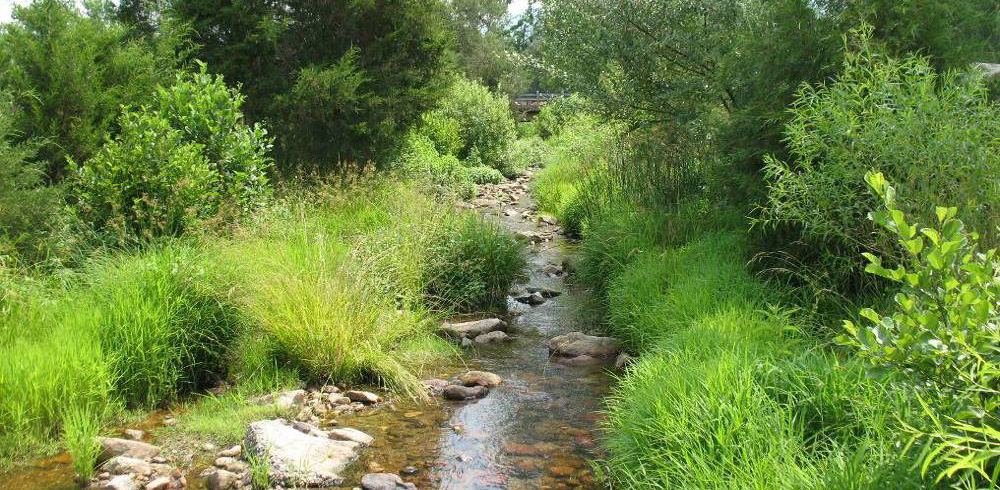by Deya Ramsden, VDOF
What comes to mind when you picture a riparian buffer? Maybe you picture hardwood seedlings in tree shelters. Or perhaps you picture the finished product of a lush green tree canopy over a stream (that’s what we strive for!) The following mini-guide is meant to present some additional types of riparian buffer to expand your view of what a riparian buffer planting can be. I’ll present the common species used in each type of buffer and highlight some of the management features. When working with the James River Buffer Program, the riparian buffer restoration manager from the James River Association or Forester from the Virginia Department of Forestry can help you create a buffer that suites your location and meets your land management needs. I hope you find this guide useful and that it sparks your imagination when planning a riparian forest buffer.
Hardwood seedlings
This may be the most common type of forested buffer. It will often include a collection of species that you would commonly see within the mature streamside forest such as silver maple, red maple or American sycamore. Some other riparian tree species additions include pin oak, river birch, black gum, bald cypress or willow.
Planting a variety of hardwoods serves as a way to jump start the progress of forest establishment and offers resiliency in the face of severe weather, pests or diseases. Protective tree shelters are often necessary to give hardwood seedlings a good start, protecting them from predation and providing a good growing environment. As the soils of riparian areas may vary in moisture level, and thus what kind of vegetation that can grow there, consult with you riparian buffer professional to pick the right species for the site.
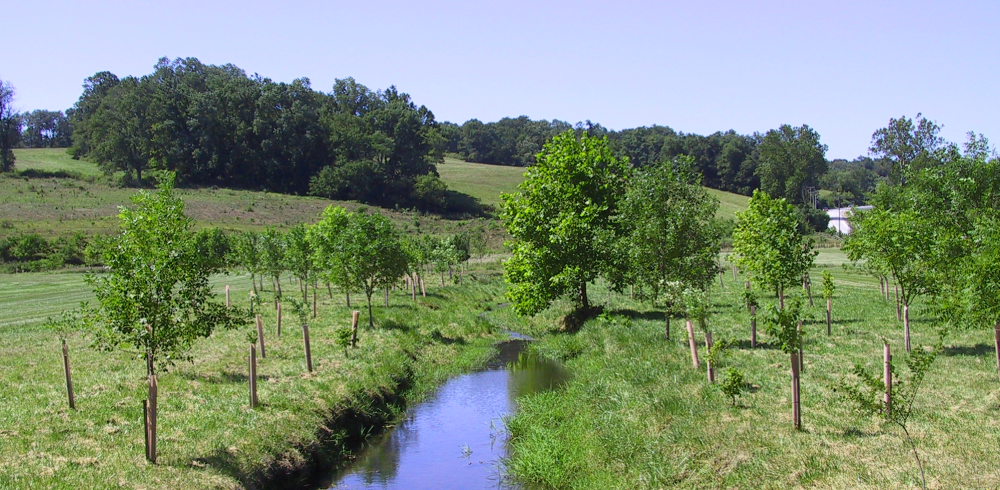
Figure 1 A hardwood riparian planting with protective shelters after 5 to 10 years (photo credit Sarah Hagan).
Hardwood seedlings that benefit wildlife or produce food
If your goal is to feed your local wildlife or even to produce food for your own consumption or sale you can choose from a variety of nut and fruit producing trees and shrubs (yes shrubs can be part of the buffer too!). Riparian soils are often quite rich and so can support a number of different species. Nut bearing trees include sawtooth oak, swamp white oak, walnut, and American hazelnut. Fruit bearers include American persimmon, paw paw, crab and common apple, red mulberry, black cherry, plum, elderberry, and serviceberry.
Your riparian buffer professional will help choose which species are most appropriate for you site. The availability of some of the above mentioned species may vary from year to year depending on local conditions.
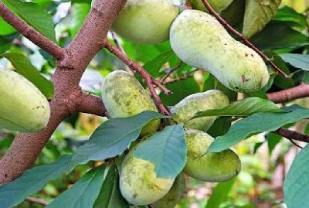
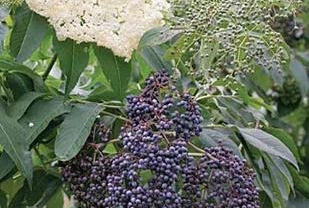
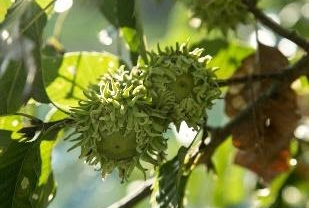
Figure 2 Paw paw tree and fruit, sawtooth oak tree and nut, elderberry fruit and flower.
A pollinator friendly buffer
If you are interested in supporting the pollinator insects in our area you can choose from a number of trees and shrubs. Trees that are great for pollinators include black locust, red bud, black gum and most of the fruit bearing trees. Shrubs include button bush, service berry and winterberry.
The open nature of young riparian areas will also support pollinators. If grass is eliminated and invasive species (i.e. highly aggressive, non-native plants) are not an issue, then many of the native wildflowers that begin to colonize will also provide food and egg laying sites for pollinators. Swamp milkweed, ironweed, cardinal flower and blue vervain are a few of the wildflowers found in open fields.
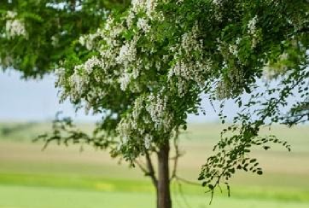
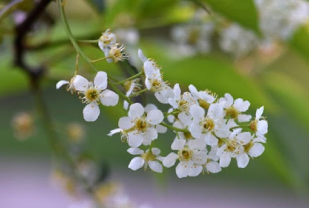
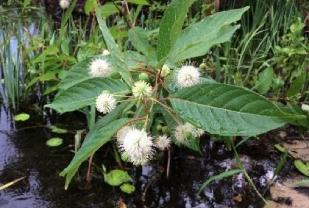
Figure 3 honey locust tree, in flower, flower of the black gum tree, button bush
Natural regeneration
Natural succession is the process by which an empty field will eventually turn into a forest. If a field is left unmown or grazing stops, seeds will take advantage of any empty space, first perennial and annual weeds will find a footing and then colonizer species of shrubs and trees that thrive in full sun and grow quickly will start to take hold. Eventually, as colonizer trees gain height they create shade which makes way for shade tolerant trees. The input of various organic matter (e.g. leaves and branches) also changes the soil, making it more favorable to tree growth and shading tolerant herbs and shrubs. Eventually, if left undisturbed, the open field becomes a forest. In the Piedmont region of Virginia this process can take between 70 to 100+ years.
The early stages of succession can be sped up by eliminating grass, fencing out cattle or other grazing animals, coupled with some careful weed control. The exposed ground then accepts the seeds of surrounding mature trees, as well as those transported by wind, animals or water. This method is appropriate for locations where a reliable and desirable tree seed source is available and where invasive species are not a threat and when you have the patience to let nature take its course. The advantage of natural regeneration is that the trees will be exactly adapted to the site.
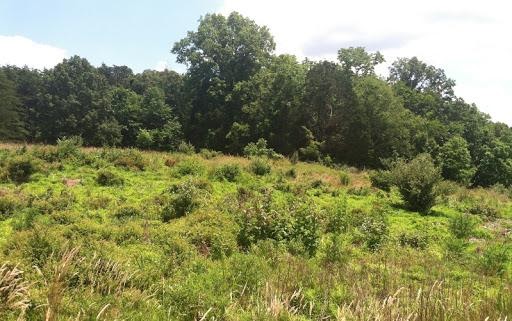
Figure 4 Example of early forest succession
Pine seedlings
A pine forest buffer may offer a number of benefits. When weed competition is controlled pine establishes quickly and since pine seedlings are less palatable to pests such as voles and deer than hardwood seedlings, seedlings do not require protective tree guards. A pine forest offers valuable habitat to white-tailed deer, grey squirrels, wild turkey and the northern bobwhite. The seeds of Loblolly pine in particular are eaten by more than 20 songbirds and some small mammals.
Planting pine is a way of supporting the natural successional process. In the Virginia Piedmont region pine is the common tree to colonize open fields during the successional process, eventually leading to the mature oak-hickory forest.
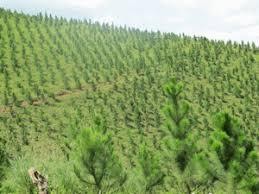
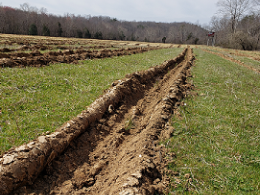
Figure 5 Pine planting after a few years, brand new pine planting with scalping (photo credit Deya Ramsden).
Planting to preserve a view shed and the watershed
If you are concerned that trees will block a cherished view, the planting palette can be altered to accomplish this goal. Trees such as red bud, service berry and many of the fruit bearing trees are appropriate for riparian areas and reach a mature height of less than 30’. A variety of shrubs can also work to anchor soils and protect waterways. Some species include silky dogwood, red osier dogwood, meadowsweet and black haw viburnum.
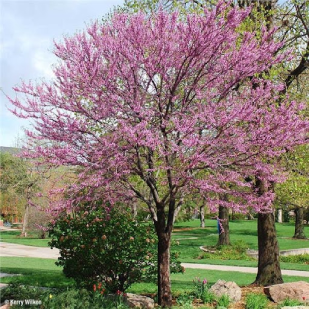
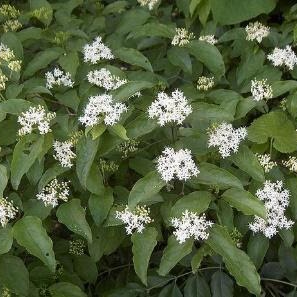
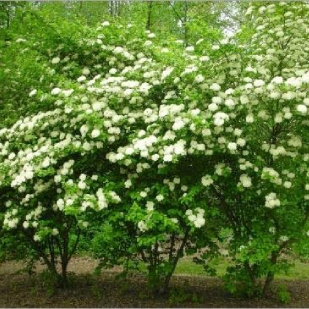
References
Carey, Jennifer H. 1992. Pinus taeda. In: Fire Effects Information
System, [Online]. U.S. Department of Agriculture, Forest Service, Rocky Mountain
Research Station, Fire Sciences Laboratory (Producer). Available: https://www.fs.fed.us/database/feis/plants/tree/pintae/all.html [2020, June 11].
Piedmont Environmental Council. “Pollinator Friendly Plants for Aquatic and Riparian Areas.” Home// Land Conservation // Managing Your Land // For Plants & Pollinators www.pecva.org/land-conservation/managing-your-land/for-plants-and-pollinators/480-pollinator-friendly-plants-for-aquatic-and-riparian-areas.
Powell, Ellen. Forest Succession, Va. Department of Education. Found on DOE website under Environmental Literacy http://www.doe.virginia.gov/instruction/environmental_literacy/va-natural/docs/vnreg-forests-forest-succession.pdf
“Riparian Buffer Zones: Common Plants.” Edited by VaDept of Forestry, Common Plants | Riparian Buffers, Virginia Department of Forestry, 2014, www.dof.virginia.gov/manage/riparian/common-plants.htm.
USDA Forest Service. Working Trees for Pollinators, USDA National Agroforestry Center, 2016, www.fs.usda.gov/nac/assets/documents/workingtrees/brochures/WTPollinators.pdf.
Va Department of Forestry. Seedling Price Guide 2019-2020, dof.virginia.gov/infopubs/Seedling-Price-Guide_2019-2020_pub.pdf.

